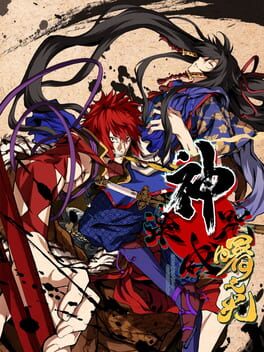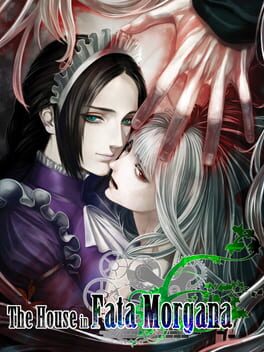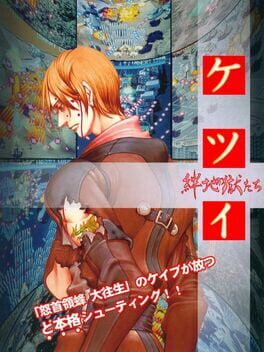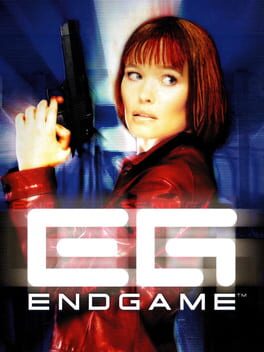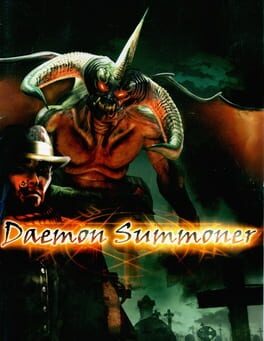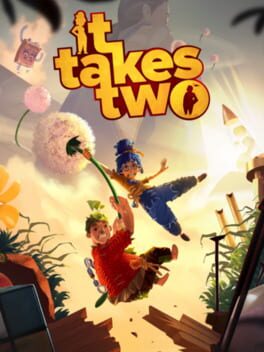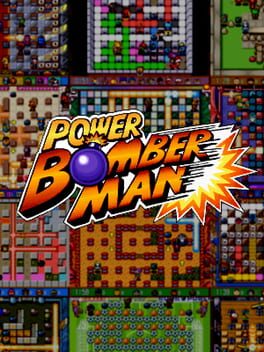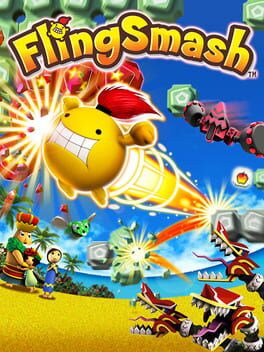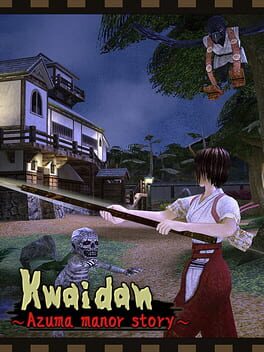BaronUnread
155 Reviews liked by BaronUnread
Kajiri Kamui Kagura
2011
the nier automata of vn sequels. reused plotlines, constant meaningless callbacks to its predecessor, gimped music, and while it has a nice art direction, it is ultimately an underwhelming experience that captures none of the magic the original experience dies irae had. after all, at its very core, it's failed to submit to the philosophy of never reminding the player they could be having a better experience. dies irae is the better experience.
however, i would recommend it if you completely forgot about most of dies irae because this vn doesn't shut up about reminding you about it every two seconds !
" pantheon would've probably been better " + jop cope + ratio / 10
bean was wrong.
however, i would recommend it if you completely forgot about most of dies irae because this vn doesn't shut up about reminding you about it every two seconds !
" pantheon would've probably been better " + jop cope + ratio / 10
bean was wrong.
A-Train PC Classic
2016
as my taste has been constantly refined by the things i consume and how i choose the things i wish to experience throughout the years, i find it harder for things to click initially with you beyond superficial factors such as "oh this cover art looks nice" or "this gameplay looks great." there are certainly games you "know" you'll enjoy once you pick it up perchance but it's even rarer however, to find a game that clicks with you initially, yet is also even better than you could've expected.
a-train pc classic is one of those games.
it's not a game i judged by its cover certainly but definitely something i found randomly one night browsing through the steam's store page and thought to myself "why is this 3ds port of a train sim priced at 60$?" apprehension aside, i was curious. in retrospect, one could argue a fool and their money are easily parted but in this case, i was making an investment of sorts leaning mostly on the personal side. yet i was no such fool, my gut knew better than to overlook the neat aesthetic and anyways i liked trains so why not check it out?
and ultimately? i'm really glad i did. what i found was not only a very comprehensive and addictive train/city sim hybrid but i also found a game filled with enough charm reminiscent of an almost bygone era in gaming, a game with a sensible size of scope, passion, and visuals that are not pushing any graphical boundaries by any means but comfortable in their presentation to match their general aesthetic. i feel that i should add that this game is quite difficult. even following the directions to a t, i find that the freedom the game allows you to have even during more guided segments definitely still often resulted in an ever-increasing mountain of debt. the point here is that failure is your greatest teacher in this game and at the end of the day, i learned a very personal thing as well. maybe i should stick to being a hobbyist and not pursue a career in railway management.
but i digress, personal lamentations aside, what's presented here is a game with a strict learning curve and an even more rewarding gameplay loop. this game, i imagine, is dedicated to a very niche demographic that appreciates the genre it represents and i think a strong reason for why this title has a lot of staying power for me personally is not only in part to its well-crafted design but the fact that it can be played in both long sessions and short bursts. it's been fun to play this daily in short bursts of "maintenance" but it also never feels tedious or draining watching your railway system grow after hour-long sessions. the soundtrack also goes really hard???? i appreciate that a lot.
anyways, should you play this game? if you like trains and the prospect of railway management sounds appealing to you then sure! if you're wondering whether this is a good entry to start, however, i'd recommend on the port of the newer switch title which at the time of writing this review comes out next month on december 7th, 2021 which is supposedly a lot more beginner-friendly and something i'll be getting around to at that time too. compared to the slump the industry experienced last year, this year was full of surprises in new titles and old titles that i discovered throughout and i'm glad to say a-train is one of them.
based tutorial secretary/10
a-train pc classic is one of those games.
it's not a game i judged by its cover certainly but definitely something i found randomly one night browsing through the steam's store page and thought to myself "why is this 3ds port of a train sim priced at 60$?" apprehension aside, i was curious. in retrospect, one could argue a fool and their money are easily parted but in this case, i was making an investment of sorts leaning mostly on the personal side. yet i was no such fool, my gut knew better than to overlook the neat aesthetic and anyways i liked trains so why not check it out?
and ultimately? i'm really glad i did. what i found was not only a very comprehensive and addictive train/city sim hybrid but i also found a game filled with enough charm reminiscent of an almost bygone era in gaming, a game with a sensible size of scope, passion, and visuals that are not pushing any graphical boundaries by any means but comfortable in their presentation to match their general aesthetic. i feel that i should add that this game is quite difficult. even following the directions to a t, i find that the freedom the game allows you to have even during more guided segments definitely still often resulted in an ever-increasing mountain of debt. the point here is that failure is your greatest teacher in this game and at the end of the day, i learned a very personal thing as well. maybe i should stick to being a hobbyist and not pursue a career in railway management.
but i digress, personal lamentations aside, what's presented here is a game with a strict learning curve and an even more rewarding gameplay loop. this game, i imagine, is dedicated to a very niche demographic that appreciates the genre it represents and i think a strong reason for why this title has a lot of staying power for me personally is not only in part to its well-crafted design but the fact that it can be played in both long sessions and short bursts. it's been fun to play this daily in short bursts of "maintenance" but it also never feels tedious or draining watching your railway system grow after hour-long sessions. the soundtrack also goes really hard???? i appreciate that a lot.
anyways, should you play this game? if you like trains and the prospect of railway management sounds appealing to you then sure! if you're wondering whether this is a good entry to start, however, i'd recommend on the port of the newer switch title which at the time of writing this review comes out next month on december 7th, 2021 which is supposedly a lot more beginner-friendly and something i'll be getting around to at that time too. compared to the slump the industry experienced last year, this year was full of surprises in new titles and old titles that i discovered throughout and i'm glad to say a-train is one of them.
based tutorial secretary/10
my personal comfort pick of 2021 and probably the most focused taro narrative in a very long time. it's not the most mechanically deep thing ever but maybe that's okay because it sure as hell doesn't overstay its welcome! i even binged it all in one long twelve hour session when it released! it's fun. it's short and sweet. it's comfy! sitting down with a nice cup of tea and warm blanket while doing some late-night gaming has never felt better.
"melanie is literally me" / 10
"melanie is literally me" / 10
What a fantastic game. Ketsui has all its elements just fall into place perfectly throughout its 5-stage run, where everything feels tightly designed and memorable.
The core gameplay element in Ketsui is the scoring system, where the player earns multiplier chips from 1 to 5 based on the proximity of the enemies destroyed. The closer you are, the higher the multiplier. Everything is designed around this scoring system and to that extent, it's what brings out the addictive and satisfying gameplay loop in Ketsui.
The game is really brutal but never unfair. Ketsui is one of the finest examples that arcade games are meant to be replayed and learned, where every second throughout its runtime is meant to be mastered. Ketsui keeps this process of learning interesting as every enemy layout is designed with the aforementioned scoring system. To play effectively, you have to be aggressive and keep in mind how the scoring works. And there are no cheap surprises, alongside minimal random factors that can sneak up behind you, any mistakes you make all feel like it's your fault rather than the game being underhanded.
Hesistation and playing it safe can actually lead to more errors and bigger obstacles over time as the enemies can pile up even more and lead to your potential death.
Each stage is also completely distinct, with its own set of enemies and completely unique patterns, which works well in creating both a challenge and a great way to make each part of the game distinctive and aid in memorization.
The attack patterns themselves feel organic, and once you learn how to get through them, it feels really good to just go with the flow and weave through them with like it's no effort. Coupled with the way you go through enemies as you rack up high multipliers consistently feels rhythm-like.
I clocked over 100 hours already with this game just to get my first single credit clear, and I'm still not tired of it. There's still a 2nd loop of the game that can be accessed, two different 2nd loops even. One where it requires the player to die or use bombs less than six times. And the even harder one, where it requires no deaths and no bombs while attaining at least 120 million in score, on which this more difficult loop features the true final boss of the game, which is also a genuine challenge on its own.
Ketsui quickly became one of my recent favorites. Alongside the strong gameplay design, there's also the great soundtrack that compliments the intensity of the game, and an excellent presentation that makes good use of pre-rendered models alongside its cohesive visual design of a grounded near-future military backdrop.
If you're a fan of shmups, or even just challenging games that you can replay over and over and find enjoyment in mastering well-designed levels and mechanics, I highly recommend checking out Ketsui.
The core gameplay element in Ketsui is the scoring system, where the player earns multiplier chips from 1 to 5 based on the proximity of the enemies destroyed. The closer you are, the higher the multiplier. Everything is designed around this scoring system and to that extent, it's what brings out the addictive and satisfying gameplay loop in Ketsui.
The game is really brutal but never unfair. Ketsui is one of the finest examples that arcade games are meant to be replayed and learned, where every second throughout its runtime is meant to be mastered. Ketsui keeps this process of learning interesting as every enemy layout is designed with the aforementioned scoring system. To play effectively, you have to be aggressive and keep in mind how the scoring works. And there are no cheap surprises, alongside minimal random factors that can sneak up behind you, any mistakes you make all feel like it's your fault rather than the game being underhanded.
Hesistation and playing it safe can actually lead to more errors and bigger obstacles over time as the enemies can pile up even more and lead to your potential death.
Each stage is also completely distinct, with its own set of enemies and completely unique patterns, which works well in creating both a challenge and a great way to make each part of the game distinctive and aid in memorization.
The attack patterns themselves feel organic, and once you learn how to get through them, it feels really good to just go with the flow and weave through them with like it's no effort. Coupled with the way you go through enemies as you rack up high multipliers consistently feels rhythm-like.
I clocked over 100 hours already with this game just to get my first single credit clear, and I'm still not tired of it. There's still a 2nd loop of the game that can be accessed, two different 2nd loops even. One where it requires the player to die or use bombs less than six times. And the even harder one, where it requires no deaths and no bombs while attaining at least 120 million in score, on which this more difficult loop features the true final boss of the game, which is also a genuine challenge on its own.
Ketsui quickly became one of my recent favorites. Alongside the strong gameplay design, there's also the great soundtrack that compliments the intensity of the game, and an excellent presentation that makes good use of pre-rendered models alongside its cohesive visual design of a grounded near-future military backdrop.
If you're a fan of shmups, or even just challenging games that you can replay over and over and find enjoyment in mastering well-designed levels and mechanics, I highly recommend checking out Ketsui.
Endgame
2002
A neat, if somewhat unremarkable Time Crisis clone.
Endgame plays nicely as far as lightgun games go, with the game taking most of its base mechanics from the first Time Crisis. With the player being equipped with a 6-shot pistol, and a cover mechanic to avoid enemy attacks while the game runs on a time limit through each section.
The enemy variety is decent enough, where you got your standard grunts as fodder, with special types such as instant damagers and shield enemies peppered in-between. The game however suffers from dull level design, where a lot of set pieces and enemy placements being repetitive. Unfortunately, this extends to most of the boss fights as well, where they just feel like spongier and harder versions of the existing enemy types.
It does somewhat pick up towards the end, with two bosses offering a more interesting dynamic. Including Endgame's own discount version of Time Crisis' Wild Dog (who also survives a few times before going down for good).
Sadly the final boss is just a remixed and amplified version of the enemy types again until the game decides to do its own cheap version of House of the Dead's Magician during its final phase.
I feel like the game could have been stronger if it removed and combined most of its stages together, and opted in for a shorter but tighter pace rather than just padding it with a lot of similar feeling levels.
I did enjoy at least the cheesy voice acting coupled with its cheap pre-rendered cutscenes. There are also some neat unlockables, including a mirror mode and dual gun mode alongside some challenge levels.
One thing in particular that I really liked was the game having a playable version of an in-universe game being played by the protagonist called 'Mighty Joe Jupiter'. It takes the base lightgun gameplay from the main game and wraps it around a cartoony sci-fi setting with aliens and such. It has its own campaign and even its own set of challenge modes which is nice.
Endgame doesn't really hold a candle as the game it takes its inspiration from, but it does still offer a fun lightgun shooter experience that's at least worth going through once.
Endgame plays nicely as far as lightgun games go, with the game taking most of its base mechanics from the first Time Crisis. With the player being equipped with a 6-shot pistol, and a cover mechanic to avoid enemy attacks while the game runs on a time limit through each section.
The enemy variety is decent enough, where you got your standard grunts as fodder, with special types such as instant damagers and shield enemies peppered in-between. The game however suffers from dull level design, where a lot of set pieces and enemy placements being repetitive. Unfortunately, this extends to most of the boss fights as well, where they just feel like spongier and harder versions of the existing enemy types.
It does somewhat pick up towards the end, with two bosses offering a more interesting dynamic. Including Endgame's own discount version of Time Crisis' Wild Dog (who also survives a few times before going down for good).
Sadly the final boss is just a remixed and amplified version of the enemy types again until the game decides to do its own cheap version of House of the Dead's Magician during its final phase.
I feel like the game could have been stronger if it removed and combined most of its stages together, and opted in for a shorter but tighter pace rather than just padding it with a lot of similar feeling levels.
I did enjoy at least the cheesy voice acting coupled with its cheap pre-rendered cutscenes. There are also some neat unlockables, including a mirror mode and dual gun mode alongside some challenge levels.
One thing in particular that I really liked was the game having a playable version of an in-universe game being played by the protagonist called 'Mighty Joe Jupiter'. It takes the base lightgun gameplay from the main game and wraps it around a cartoony sci-fi setting with aliens and such. It has its own campaign and even its own set of challenge modes which is nice.
Endgame doesn't really hold a candle as the game it takes its inspiration from, but it does still offer a fun lightgun shooter experience that's at least worth going through once.
Daemon Summoner
2006
It Takes Two
2021
Really fun! It Takes Two is the kind of game that does a lot of things, and for the most part, does it well. Coming from the same developers of the co-op-only game A Way Out, It Takes Two takes that familiar brand into a more gameplay-oriented experience.
The game at its core is a 3D platformer and builds on top of that by throwing a variety of different gameplay concepts and scenarios built around the co-op experience.
There's a lot of enjoyable platforming sections, and while going through them, you and your friend will be occupied as well with a different gimmick through each chapter of the game. Such gimmicks come in a mixture of different combat methods such as having one player cover enemies and obstacles with a flammable sap that the other player can detonate with their own unique fire projectile.
During sections where it takes a focus on puzzles instead, you get different gimmicks such as the player navigating through an obstacle while another uses a device or ability to help the other player get through things. I found myself just enjoying spitballing ideas and figuring things out with my friends, and on the times we got stuck, it's less on the game being obtuse and just more on us just having moments of hilarious stupidity, which is its own kind of fun.
Optional activities also are peppered throughout the game, with various competitive minigames and moments of exploration to serve as breathers between chapters. If you loved goofing off and playing minigames such as Connect Four in A Way Out, It Takes Two amplifies that idea further in this game.
The game keeps this pacing mostly consistent throughout, and you'll never be doing the same thing twice. However, it does feel like the ideas start to falter towards the end, where the new gimmicks start just feeling like less interesting variations of what you were doing a few hours earlier. The game could have merged and cut out a few things to make the experience tighter and make the last hour less of a slog. Still, for the most part, there's hardly a dull moment throughout the game thanks to just the sheer variety it offers throughout the hours.
Visually, the game looks fantastic. The environment variety alone is great, but the details put into them really show how much work is poured into the game. From experiencing daily household areas as miniature toys to beautiful snowy mountains, green gardens, and even really abstract spaces, it consistently manages to look really good.
The narrative itself unfortunately isn't as compelling as A Way Out, and at best you might find the dialogue passable with a few chuckle-worthy moments, and at worst annoying. Nevertheless, the premise does serve its purpose as a vehicle for the scenarios you go through the game, and it does have a few notable moments, which I won't spoil, but I can say that it's both hilarious and horrifying and can guarantee that it will elicit a reaction.
It isn't a deal-breaker but it would have been interesting to see if they minimized the plot further and just focused on the gameplay parts, as I feel like it is enough to carry the game, and taking out the story won't really impact the main enjoyment of the gameplay itself.
I personally played this twice with two different friends, with the playthrough months apart to keep my experience somewhat fresh, and absolutely enjoyed both playthroughs and had fun rediscovering solutions to the game, alongside finding new stuff I didn't come across on my initial playthrough. It isn't the easiest game to do full replays with considering its long length, though the option for chapter selections and jumping through minigames instantly is a nice way to do bite-sized revisits.
All in all, It Takes Two is a really enjoyable experience, and there is a lot of fun stuff to go through even on just a single playthrough. Like the neat thing with A Way Out, only one of you needs a copy to play the game together. If you're in the mood for a fun co-op experience, It Takes Two will provide a solid experience.
The game at its core is a 3D platformer and builds on top of that by throwing a variety of different gameplay concepts and scenarios built around the co-op experience.
There's a lot of enjoyable platforming sections, and while going through them, you and your friend will be occupied as well with a different gimmick through each chapter of the game. Such gimmicks come in a mixture of different combat methods such as having one player cover enemies and obstacles with a flammable sap that the other player can detonate with their own unique fire projectile.
During sections where it takes a focus on puzzles instead, you get different gimmicks such as the player navigating through an obstacle while another uses a device or ability to help the other player get through things. I found myself just enjoying spitballing ideas and figuring things out with my friends, and on the times we got stuck, it's less on the game being obtuse and just more on us just having moments of hilarious stupidity, which is its own kind of fun.
Optional activities also are peppered throughout the game, with various competitive minigames and moments of exploration to serve as breathers between chapters. If you loved goofing off and playing minigames such as Connect Four in A Way Out, It Takes Two amplifies that idea further in this game.
The game keeps this pacing mostly consistent throughout, and you'll never be doing the same thing twice. However, it does feel like the ideas start to falter towards the end, where the new gimmicks start just feeling like less interesting variations of what you were doing a few hours earlier. The game could have merged and cut out a few things to make the experience tighter and make the last hour less of a slog. Still, for the most part, there's hardly a dull moment throughout the game thanks to just the sheer variety it offers throughout the hours.
Visually, the game looks fantastic. The environment variety alone is great, but the details put into them really show how much work is poured into the game. From experiencing daily household areas as miniature toys to beautiful snowy mountains, green gardens, and even really abstract spaces, it consistently manages to look really good.
The narrative itself unfortunately isn't as compelling as A Way Out, and at best you might find the dialogue passable with a few chuckle-worthy moments, and at worst annoying. Nevertheless, the premise does serve its purpose as a vehicle for the scenarios you go through the game, and it does have a few notable moments, which I won't spoil, but I can say that it's both hilarious and horrifying and can guarantee that it will elicit a reaction.
It isn't a deal-breaker but it would have been interesting to see if they minimized the plot further and just focused on the gameplay parts, as I feel like it is enough to carry the game, and taking out the story won't really impact the main enjoyment of the gameplay itself.
I personally played this twice with two different friends, with the playthrough months apart to keep my experience somewhat fresh, and absolutely enjoyed both playthroughs and had fun rediscovering solutions to the game, alongside finding new stuff I didn't come across on my initial playthrough. It isn't the easiest game to do full replays with considering its long length, though the option for chapter selections and jumping through minigames instantly is a nice way to do bite-sized revisits.
All in all, It Takes Two is a really enjoyable experience, and there is a lot of fun stuff to go through even on just a single playthrough. Like the neat thing with A Way Out, only one of you needs a copy to play the game together. If you're in the mood for a fun co-op experience, It Takes Two will provide a solid experience.
Resident Evil 4 VR
2021
It really is just RE4 VR.
Overall the game's quite easier from the fact that you directly are the one handling the reloading, knife slashing, and aiming. If you have played vr shooters before and are fast with the hand movements involved with that, you can always reload just in time to land a stagger shot, slash quick enough to kill a ganado before they get back up, or pull off a snap shot on a ganado that's snuck up on you.
It's much easier to avoid damage in this game especially with the fact that you aren't tied to the tank controls anymore, although you can enable something similar to that old control scheme if you'd like.
I have a small gripe with the item management where due to the way you grab items and they automatically get put into your inventory, you can't do on the fly inventory management when your shits all full up. You can't pick up an herb and combine it when the game puts you into the inventory screen anymore cause in this it just plays a noise and says "inventory full". Slightly annoying but nothing big.
A big thing is the fact that they took out the extra game modes. Now I didn't really care for Assignment:Ada and tbh I don't know many people who did, but did they really have to take out Separate Ways and Mercenaries? That's just corny. At least mercenaries would've been nice to give some extra shit to do aside from just replaying the main game.
The camera does shift perspective when doing some actions and that's to appease the stomachlets who got into vr but it doesn't really bother me too much, although it would be cool to shake off a ganado that's right in your face.
I don't care about the minor censorship considering this is my 7th playthrough of RE4 and I just skip every cutscene so it's not like I'd notice the censorship if I were never told about it.
Overall, it's nice. It's competently made in the sense that it's just RE4's main campaign in VR. They could've done more with this but what we have is pretty damn good. I'll definitely do a Professional run of this whenever I'm done with the main game.
Krauser is even easier to fight now
Well they added Mercenaries, costume special 2, the handcannon, and the tommy so that's cool. The scoring for mercenaries is a bit different but that's a nonissue. They also added a bunch of gimmick challenges which aren't too difficult and can be pretty enjoyable. Still no Separate Ways though and its probably not coming, whatever.
Overall the game's quite easier from the fact that you directly are the one handling the reloading, knife slashing, and aiming. If you have played vr shooters before and are fast with the hand movements involved with that, you can always reload just in time to land a stagger shot, slash quick enough to kill a ganado before they get back up, or pull off a snap shot on a ganado that's snuck up on you.
It's much easier to avoid damage in this game especially with the fact that you aren't tied to the tank controls anymore, although you can enable something similar to that old control scheme if you'd like.
I have a small gripe with the item management where due to the way you grab items and they automatically get put into your inventory, you can't do on the fly inventory management when your shits all full up. You can't pick up an herb and combine it when the game puts you into the inventory screen anymore cause in this it just plays a noise and says "inventory full". Slightly annoying but nothing big.
The camera does shift perspective when doing some actions and that's to appease the stomachlets who got into vr but it doesn't really bother me too much, although it would be cool to shake off a ganado that's right in your face.
I don't care about the minor censorship considering this is my 7th playthrough of RE4 and I just skip every cutscene so it's not like I'd notice the censorship if I were never told about it.
Overall, it's nice. It's competently made in the sense that it's just RE4's main campaign in VR. They could've done more with this but what we have is pretty damn good. I'll definitely do a Professional run of this whenever I'm done with the main game.
Krauser is even easier to fight now
Well they added Mercenaries, costume special 2, the handcannon, and the tommy so that's cool. The scoring for mercenaries is a bit different but that's a nonissue. They also added a bunch of gimmick challenges which aren't too difficult and can be pretty enjoyable. Still no Separate Ways though and its probably not coming, whatever.
Power Bomberman
2013
Tightly designed Bomberman game with an insane amount of content. Fair amount of game modes with each level having a unique gimmick and filled with neat details, on top of having variations to choose for each level.
Online works wonderfully with a painless setup even across different countries.
There's so much content from across different Bomberman games, including ones you most likely haven't heard of, on top of different IP cameos. Everyone is acquired through an in-game gacha using coins you earn just by playing.
Amazing how all of this is for a free fangame, and it's still in development as of writing this, yet feels feature complete. If you're looking for a party game with a group of friends, this is definitely something to try out.
Online works wonderfully with a painless setup even across different countries.
There's so much content from across different Bomberman games, including ones you most likely haven't heard of, on top of different IP cameos. Everyone is acquired through an in-game gacha using coins you earn just by playing.
Amazing how all of this is for a free fangame, and it's still in development as of writing this, yet feels feature complete. If you're looking for a party game with a group of friends, this is definitely something to try out.
FlingSmash
2010
Metroid
1986
Felt nice to finally say I beat it, especially fun contrasting it with the most recent Metroid game, Dread. I always find it crazy to think this was a game made around the time as the first Zelda.
I don't think this game is nearly as competently made as that but it's a pretty fun platforming game for the time and it does still have that satisfying sense of progression that was later mastered in newer games.
I try my best to look at this in the sense of a game at the time, and I think it's pretty good, but now the fact that every map looks samey and the EXTREME amount of grinding (gets a little better in the end game with metroids dropping 30 of items as well as having the screw attack) but it makes the early game really annoying and was a major reason I never beat the game until now.
This game is pretty much obsoleted by Zero Mission, but probably worth checking out for the historical curiousity, and I think outside of those two things the game is quite charming and fun.
I can also shoutout Metroid mOTHER + 99 Hack, while I haven't played it all the way through, and I did this run purely vanilla, it does address those issues mainly, starting with full health after you die, as well as adding a minimap you can use! If you want to play Metroid with a more modern touch I'd play this hack but I really suggest trying it in it's original form first.
I don't think this game is nearly as competently made as that but it's a pretty fun platforming game for the time and it does still have that satisfying sense of progression that was later mastered in newer games.
I try my best to look at this in the sense of a game at the time, and I think it's pretty good, but now the fact that every map looks samey and the EXTREME amount of grinding (gets a little better in the end game with metroids dropping 30 of items as well as having the screw attack) but it makes the early game really annoying and was a major reason I never beat the game until now.
This game is pretty much obsoleted by Zero Mission, but probably worth checking out for the historical curiousity, and I think outside of those two things the game is quite charming and fun.
I can also shoutout Metroid mOTHER + 99 Hack, while I haven't played it all the way through, and I did this run purely vanilla, it does address those issues mainly, starting with full health after you die, as well as adding a minimap you can use! If you want to play Metroid with a more modern touch I'd play this hack but I really suggest trying it in it's original form first.
Like it's predecessor, another game that's really good for it's time but hasn't aged well at all and in pretty much every way outside of some minor points the remakes, especially AM2R are just kind of better.
Though I think this game has different strengths and issues compared to the first metroid, on the good side, Samus controls MUCH better in this game than she does in the original, being able to aim in every direction and the physics to the jumps feel nice.
The world is kind of a double edged sword, on one hand, it uses many more unique screens than the original Metroid which had a habit of repeating things constantly. On the other, the game feels much less vast and interesting than the original in my opinion. The Metroid fights aren't very good and there's less cool secrets hidden around the map unlike the first game.
Regardless of that, the strengths of Metroid II are very obvious in what will come 3 years later in Super, the first amazing Metroid game. So I can't say this game is any worse than 1 but I'd consider them equals with very different strengths and weaknesses.
I would definetly try this version out, there's also a pretty cool colorization hack that gives areas a little more of a sense of identity, which is nice. Of course, AM2R and Samus Returns are must plays, but I think you should check out the original first to get an appreciation for it.. It IS only about 5 hours long!
Though I think this game has different strengths and issues compared to the first metroid, on the good side, Samus controls MUCH better in this game than she does in the original, being able to aim in every direction and the physics to the jumps feel nice.
The world is kind of a double edged sword, on one hand, it uses many more unique screens than the original Metroid which had a habit of repeating things constantly. On the other, the game feels much less vast and interesting than the original in my opinion. The Metroid fights aren't very good and there's less cool secrets hidden around the map unlike the first game.
Regardless of that, the strengths of Metroid II are very obvious in what will come 3 years later in Super, the first amazing Metroid game. So I can't say this game is any worse than 1 but I'd consider them equals with very different strengths and weaknesses.
I would definetly try this version out, there's also a pretty cool colorization hack that gives areas a little more of a sense of identity, which is nice. Of course, AM2R and Samus Returns are must plays, but I think you should check out the original first to get an appreciation for it.. It IS only about 5 hours long!
Throwback survival horror can be tricky to pull off. A lot of attempts end up missing the point of what makes older titles engaging, where a lot just throw in a pixelated filter, low polygon models, fixed camera angles and call it “inspired by classics such as Resident Evil and Silent Hill” and end up just feeling like a half-hearted attempt at it, with visuals that feel genuinely worse than any game from that period and gameplay that feels similar to contemporary dime-a-dozen asset flips.
Which makes Kwaidan a standout, for better and worse, as it genuinely feels like a survival horror game that came from the early 2000s, alongside the associated charms, warts and all.
Before diving into Kwaidan, the player is given the option to select either ‘Origin mode’ or ‘Modern mode’. ‘Origin mode’ uses tank controls with a keyboard and mouse, whereas ‘Modern mode’ uses direct controls with a gamepad. An odd quirk that’s tied to each mode is the visual style, where ‘Origin mode’ has a clean look and ‘Modern mode’ uses cel-shading. Both modes look fine visually, but it’s a weird choice to tie these styles to a given control method.
Both control methods work well enough, but I personally prefer the ‘Origin mode’ as I feel like the tank controls and use of mouse for the inventory and exploration works better for the overall experience. Although I will admit ‘Modern mode’ can feel a bit more fluid in some combat scenarios. Either option will also take some time to get used to, as there is a bit of jank to consider, but thankfully you only need to take note straightforward concepts with movement, weapon switching, quick turning and blocking.
The game wastes no time in throwing the player into actual gameplay. At the start, a brief tutorial serves to familiarize the player with its movement and combat mechanics, and immediately starts the player off with a boss fight. This kind of first impression also serves as an indicator of how the game is paced throughout.
The combat mechanics themselves are rather straightforward, but feels unique for a survival horror game. It’s a mostly melee focused system, but not exactly in an action hack-and-slash fashion. You have three options to cycle through on the fly. You have a regular attack that hits opponent in the middle about your height with the naginata, a mirror amulet that serves as an aerial attack for enemies above you, and a magatama which explodes with a small area of effect, which is primarily for enemies that your naginata can’t reach but can also serve well for crowd control. The latter two options consume ‘magic’ which you can replenish by killing enemies and blocking attacks.
The combat emphasizes positioning and timing, where you learn how each enemy moves and attacks. It’s rare to find yourself in a position that you can’t fight off enemies, as they all go down in one to two hits. It feels pretty good as well to master how the combat works and familiarize yourself with how each enemy works. This then extends to how resource management works. You only have two types of consumables, which is a healing item and an item that allows you to save or upgrade your weapons.
Saving works by using save amulets on shrines. Healing items are one-time use and heal about 40% of your health. The way these all works create the tension on how you approach combat, as while you never really run out of options to dispatch enemies, your character is completely vulnerable with limited ways to recover. Aggression is often punished and you have to take a patient approach on even the simplest enemy or else risk losing a bit of health that can set you back in the long term.
The game does balance resource distribution well enough, where you won’t have an abundance to just steamroll through everything, but you aren’t exactly starved off either to the point of frustration.
On top of the consumable healing items, there are a few spots that the player can eat or drink from a single time, which is a nice touch as well in giving an incentive to explore environmental backdrops.
The majority of the game takes place in the titular Azuma Manor, and it is quite a nice set piece to explore. There’s no space wasted, with each area serving a purpose, even if it isn’t obvious during the first encounter. Backtracking is also made less painful as you progress, you’ll uncover new shortcuts that interconnect parts of the manor even more.
All of this is further enhanced with the overall presentation. The visuals do feel like a game that’s trying its best to look good with early 2000s technological limitations, while having a few liberties here and there that further serves its purpose to enrich the visuals. On top of that, the game has a nice mix of piano and electronic music that serves the atmosphere and mood quite well.
The enemy designs themselves are all distinct, with animations and looks that look good and help in recognizing them on the fly during tense combat scenarios.
The boss fights themselves are neat, nothing amazing but they serve a good purpose of looking intimidating at first especially with how your character controls, but figuring out how their attack patterns work which encourages more on careful observation rather than just brute force.
Puzzle solving is also mostly straightforward, and a couple challenging ones that may require taking physical notes or screenshots. They aren’t too ridiculous and are fun to solve, but it actually would have been nice to have an option in-game to review what you found. It can be argued this serves to further enhance that ‘throwback feel’ where some games forced the player to actually whip out a pencil and paper to map things out themselves, but I feel like it just adds unnecessary tedium.
Speaking of tedium, without spoiling too much details, the game unfortunately loses some steam during the final stretch. You go through a new area which is a lot more boring visually compared to the manor, and it’s filled with some really frustrating moments. Enemies can just spawn suddenly near you and you have to keep in mind to block.
One moment in particular that stood out like a sore thumb is a part where you have to backtrack to somewhere while having no option to run or attack. All of this with enemies still chasing you and a timed obstacle you have to avoid. It’s not a deal breaker but considering how well paced the previous section was, it really stands out in a negative way.
You’re also forced to fight the previous two bosses again before the final boss, but this time with more health and enemies spawn alongside. This is less challenging and more on just making the same fights drag on longer. Which is pretty bad since the interesting part about these bosses are more on figuring out the safest approach how to damage them rather than repeating it numerous times.
At the very least the final boss is a bit creative, if somewhat a bit long as well. It’s a bit overwhelming at first, but once you figure it out it feels satisfying to do so. My only complaint is that it really could had its health lowered a bit and would have helped it flow better without losing its challenge.
In the end, despite lacking some polish and the noticeable flaws towards the final hour of the game, I still enjoyed playing through Kwaidan. It’s impressive how this is all made by a solo developer, and I think he managed to succeed in capturing the spirit of a classic survival horror game, even if it doesn’t exactly land on all of its ideas. There's a lot of charm to the presentation and atmosphere, and the largest chunk of the game is thankfully spent during its best parts.
If you’re a fan of said classic survival horror, and you have the patience for some jank, I definitely recommend giving Kwaidan a go.
Which makes Kwaidan a standout, for better and worse, as it genuinely feels like a survival horror game that came from the early 2000s, alongside the associated charms, warts and all.
Before diving into Kwaidan, the player is given the option to select either ‘Origin mode’ or ‘Modern mode’. ‘Origin mode’ uses tank controls with a keyboard and mouse, whereas ‘Modern mode’ uses direct controls with a gamepad. An odd quirk that’s tied to each mode is the visual style, where ‘Origin mode’ has a clean look and ‘Modern mode’ uses cel-shading. Both modes look fine visually, but it’s a weird choice to tie these styles to a given control method.
Both control methods work well enough, but I personally prefer the ‘Origin mode’ as I feel like the tank controls and use of mouse for the inventory and exploration works better for the overall experience. Although I will admit ‘Modern mode’ can feel a bit more fluid in some combat scenarios. Either option will also take some time to get used to, as there is a bit of jank to consider, but thankfully you only need to take note straightforward concepts with movement, weapon switching, quick turning and blocking.
The game wastes no time in throwing the player into actual gameplay. At the start, a brief tutorial serves to familiarize the player with its movement and combat mechanics, and immediately starts the player off with a boss fight. This kind of first impression also serves as an indicator of how the game is paced throughout.
The combat mechanics themselves are rather straightforward, but feels unique for a survival horror game. It’s a mostly melee focused system, but not exactly in an action hack-and-slash fashion. You have three options to cycle through on the fly. You have a regular attack that hits opponent in the middle about your height with the naginata, a mirror amulet that serves as an aerial attack for enemies above you, and a magatama which explodes with a small area of effect, which is primarily for enemies that your naginata can’t reach but can also serve well for crowd control. The latter two options consume ‘magic’ which you can replenish by killing enemies and blocking attacks.
The combat emphasizes positioning and timing, where you learn how each enemy moves and attacks. It’s rare to find yourself in a position that you can’t fight off enemies, as they all go down in one to two hits. It feels pretty good as well to master how the combat works and familiarize yourself with how each enemy works. This then extends to how resource management works. You only have two types of consumables, which is a healing item and an item that allows you to save or upgrade your weapons.
Saving works by using save amulets on shrines. Healing items are one-time use and heal about 40% of your health. The way these all works create the tension on how you approach combat, as while you never really run out of options to dispatch enemies, your character is completely vulnerable with limited ways to recover. Aggression is often punished and you have to take a patient approach on even the simplest enemy or else risk losing a bit of health that can set you back in the long term.
The game does balance resource distribution well enough, where you won’t have an abundance to just steamroll through everything, but you aren’t exactly starved off either to the point of frustration.
On top of the consumable healing items, there are a few spots that the player can eat or drink from a single time, which is a nice touch as well in giving an incentive to explore environmental backdrops.
The majority of the game takes place in the titular Azuma Manor, and it is quite a nice set piece to explore. There’s no space wasted, with each area serving a purpose, even if it isn’t obvious during the first encounter. Backtracking is also made less painful as you progress, you’ll uncover new shortcuts that interconnect parts of the manor even more.
All of this is further enhanced with the overall presentation. The visuals do feel like a game that’s trying its best to look good with early 2000s technological limitations, while having a few liberties here and there that further serves its purpose to enrich the visuals. On top of that, the game has a nice mix of piano and electronic music that serves the atmosphere and mood quite well.
The enemy designs themselves are all distinct, with animations and looks that look good and help in recognizing them on the fly during tense combat scenarios.
The boss fights themselves are neat, nothing amazing but they serve a good purpose of looking intimidating at first especially with how your character controls, but figuring out how their attack patterns work which encourages more on careful observation rather than just brute force.
Puzzle solving is also mostly straightforward, and a couple challenging ones that may require taking physical notes or screenshots. They aren’t too ridiculous and are fun to solve, but it actually would have been nice to have an option in-game to review what you found. It can be argued this serves to further enhance that ‘throwback feel’ where some games forced the player to actually whip out a pencil and paper to map things out themselves, but I feel like it just adds unnecessary tedium.
Speaking of tedium, without spoiling too much details, the game unfortunately loses some steam during the final stretch. You go through a new area which is a lot more boring visually compared to the manor, and it’s filled with some really frustrating moments. Enemies can just spawn suddenly near you and you have to keep in mind to block.
One moment in particular that stood out like a sore thumb is a part where you have to backtrack to somewhere while having no option to run or attack. All of this with enemies still chasing you and a timed obstacle you have to avoid. It’s not a deal breaker but considering how well paced the previous section was, it really stands out in a negative way.
You’re also forced to fight the previous two bosses again before the final boss, but this time with more health and enemies spawn alongside. This is less challenging and more on just making the same fights drag on longer. Which is pretty bad since the interesting part about these bosses are more on figuring out the safest approach how to damage them rather than repeating it numerous times.
At the very least the final boss is a bit creative, if somewhat a bit long as well. It’s a bit overwhelming at first, but once you figure it out it feels satisfying to do so. My only complaint is that it really could had its health lowered a bit and would have helped it flow better without losing its challenge.
In the end, despite lacking some polish and the noticeable flaws towards the final hour of the game, I still enjoyed playing through Kwaidan. It’s impressive how this is all made by a solo developer, and I think he managed to succeed in capturing the spirit of a classic survival horror game, even if it doesn’t exactly land on all of its ideas. There's a lot of charm to the presentation and atmosphere, and the largest chunk of the game is thankfully spent during its best parts.
If you’re a fan of said classic survival horror, and you have the patience for some jank, I definitely recommend giving Kwaidan a go.
